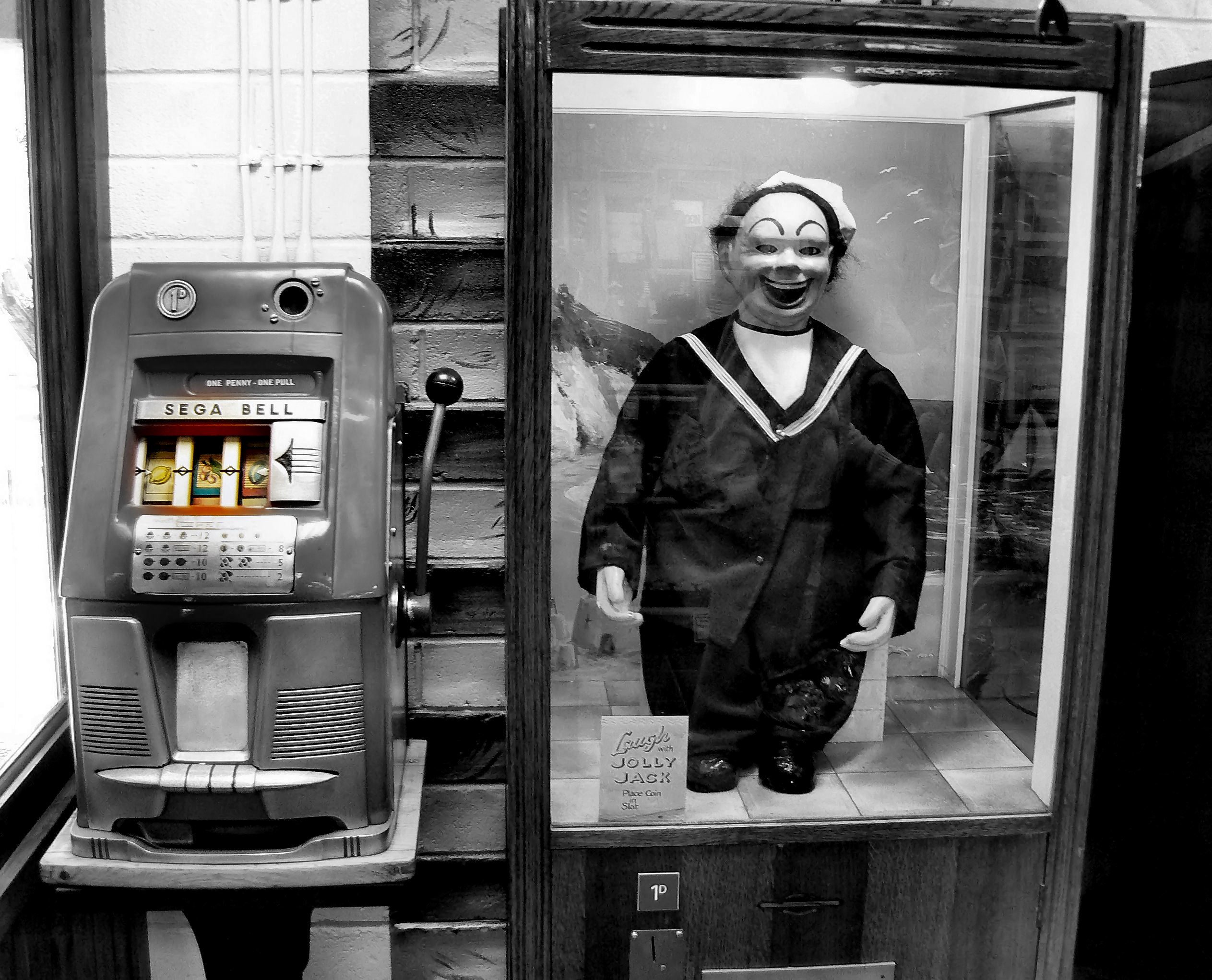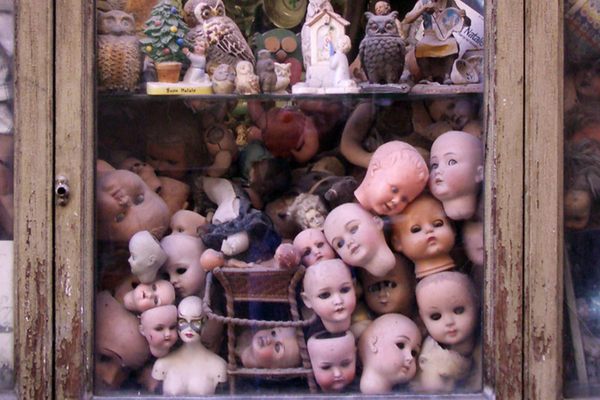The Story of Laffing Sal, the World’s Most Uncanny Animatronic Doll
Six-feet-tall and pure nightmare, she was once one of America’s most popular funhouse amusements.

Laffing Sal at Fisherman’s Wharf in San Francisco. (Photo: Gary Stevens/CC BY 2.0)
You’ll know her by the trail of sobbing children.
Follow the line of confused faces, and you’ll find the 6-foot-tall, freckled, curly-haired, gap-toothed animatronic monstrosity. As an antique that’s still in use, there’s something both dated and timeless about her. Her outsides are papier-mâché, her insides are carefully-set springs and gears, and she moves with the confidence of an alien spy testing their human body disguise, and laughs in a pitch that conjures visions of demons or the final thing you see before you die.
She is Laffing Sal, a horror-show designed to brighten your day.
While you may have never laid eyes on a Laffing Sal personally, she’s permeated our pop culture in ways that few other dolls have. Sal’s appeared in The Princess Diaries, the classic noir Woman on the Run, and Fritz Lang’s thriller M. Her manic laughter is hidden deep within the background of Neutral Milk Hotel’s In the Aeroplane Over the Sea. (As noted in Kim Cooper’s 33 1/3 book on the album, the band recorded her soundtrack surreptitiously while in San Francisco’s Musée Méchanique.) And she’s made appearances in nearly any episode of television set at an amusement park, the arena she was originally designed to haunt.

There she is, in San Francisco. (Photo: jjron, GFDL 1.2)
There was a time when the U.S. was blanketed in an army of Sals, constructed by the Philadelphia Toboggan Company (PTC), based in Germantown, Pennsylvania, a manufacturer that specialized in building amusement park rides and attractions since 1904. This mostly meant wooden roller coasters (according to PTC, 82 of them are still in operation today), carousels, Skee Ball machines, and “Crazy Daisy” rides, those teacup-like twirling attractions. But in the 1930s, the PTC got into the papier-mâché game.
They subcontracted the work to Canton, Ohio’s Old King Cole company, who first used their thrifty construction techniques to more exotically decorate the rides before constructing stand-alone figures. Early contracts included one with RCA to mass produce replicas of Nipper, the sweet pooch attentively listening to a phonograph, and to department stores around the country, to build laughing animatronic Santa Clauses displayed during Christmas. One day, someone had the clever idea the latter may have more value if not relegated to seasonal employment. As Bill Luca, creator director for the dark carnival ride fansite “Laff in the Dark,” described in his history of Sal, the Santa modification involved “substituting a woman’s head and legs, making some anatomical enhancements and dressing the figure in a frumpy dress, jacket and hat.”

The Big Dipper roller coaster at San Francisco’s Playland at the Beach. (Photo: Smith, James R./CC BY-SA 3.0)
This new thing had two moves. Her torso shifted forward and back with a belly-laugh, causing her spring-loaded head to bounce in awkward nods. Another gear moved her arms up and down, as if telling everyone around her to calm down. She also had speakers positioned at the base which played her laugh on repeat. (Originally, it came from a stack of 78 rpm records that needed to be changed periodically by a technician, before tape cartridges automated that job.) It all added up to an early precursor of uncanny valley robotics, humanoid replicas that cause passersby to stare at this weird contraption and wonder if someone was inside staring back.
Since Sal’s debut, the reaction to her spastic movements and ear-piercing giggle has been that perfect mix of intrigue and cringe that gets us to buy a ticket to a thriller, only to watch half of it through shielding fingers. In other words, the funhouse aesthetic. So, when the PTC began selling and installing their new funhouses into amusement parks, it was only natural that Sal came along for the ride.

A Laffing Sal at the Santa Cruz Beach Boardwalk. (Photo: mk97007/CC BY 2.0)
No one’s sure how many Sals were made. Some reports say 250, others push that number to 500, but then comes the question of what one considers “original” in the official tally. They went for about $360 a pop back in 1940s dollars, nearly $6,200 today, but that hefty price tag wasn’t off-putting to carnival attraction owners. Sal was so popular, in fact, the PTC commissioned male counterparts, Laffing Sams, as well as offshoot characters that tweaked the look, like Laffing Farmer, Giggling Gertie, and Blackie the Sideshow Barker. But Sal was the most popular—most had multiple versions on hand in case one broke down.
Unfortunately, there’s no complete list or map of the Sals left—no one knows how many lie buried in the depths of long-forgotten warehouses, waiting to send shivers down the eventual discoverer’s spine—although Wikipedia does collect a number of examples.

An alternate version of Sal—“Jolly Jack”. (Photo: Ronald Saunders, CC BY-SA 2.0)
One particularly Sal hotspot is the Bay Area. Playland at the Beach, a seaside amusement park that was located at the western most end of San Francisco, down the coast from Sutro’s Bath and Cliff House has long been a destination for Sal-lovers. The area was an unofficial settlement for transients in the late 1800s until the first amusement ride (a roller coaster) was installed in 1884. Other rides and attractions soon followed, and in 1926, George Whitney became the general manager of the complex, now given name and order. When funhouses opened in the 30s, so came the Sals, where they rocked and laughed, and terrorized, until the land was sold to a “naval-less” condominium developer in 1971.
Following the demolition, one Sal—Playland had at least two—wound up in the private collection of John Wickett, a Bay Area eccentric who displayed it in his Museum of Exotica. After his death in 2003, the collection went up for auction. Charles Canfield, president of the Santa Cruz Beach Boardwalk, put in a bid.
“[Canfield] has a great sense of the nostalgia and history of the amusement park history,” says Jessie Durant, the boardwalk’s archivist. The company paid $50,000 and gave Sal a makeover—reworking her body, rebuilding her transmission, replacing her motor, digitizing her soundtrack—before placing her in a glass case outside of Neptune’s Kingdom, their mini-golf and arcade complex. “Apparently, there’s controversy whether or not our Sal has her original head,” says Durant. “But she’s still working every day, laughing away, making other people laugh, or run away.”

San Francisco’s Playland at the Beach, where Laffing Sal first appeared. (Photo: wackystuff/CC BY-SA 2.0)
Playland-Not-at-the-Beach, an odd little museum in El Cerrito claims two Sals. One is a classic PTC creation from a collector in Ohio, while the one (dubbed Sinister Sal) is a contemporary update to the genre designed by sculptor Chuck Jarman. “On special occasions,” reads the website, “we have even let Psycho Sal out of her cage, but she’s definitely not for the kids!”
The most-visited Sal in the Bay, though, is located near the entrance of Musée Méchanique, the famed collection of vintage penny arcade machines and moving dioramas at the edge of Fisherman’s Wharf. Dan Zelinsky, the museum’s director, recalls getting Sal about two decades ago for a price tag near $3,000. “[The seller] called me to come over to his house and look at it,” says Zelinsky. “He had housed it in his stairwell under a blanket. I said, looks great, and went back with a check. But then he decided not to sell it.”
Years later, the seller passed away and his family put it up for auction, and Zelinsky pounced, both for practical purposes (“it’s multilingual, it’s something that everyone around the world can relate to”) and his own personal nostalgia (as a kid, Zelinsky often visited Sal outside of the funhouse at Playland.) And now, Sal’s back where she belongs, greeting new visitors who either chortle with delight or pant with terror, mostly the latter.
“Kids are scared to death of that thing,” Zelinsky says, a certain glee in his voice. “Their parents bring them in because they grew up going to Playland, so they start it up, and their kids hide. They’re like, ‘Mom, are you sure this is supposed to be fun?’”















Follow us on Twitter to get the latest on the world's hidden wonders.
Like us on Facebook to get the latest on the world's hidden wonders.
Follow us on Twitter Like us on Facebook